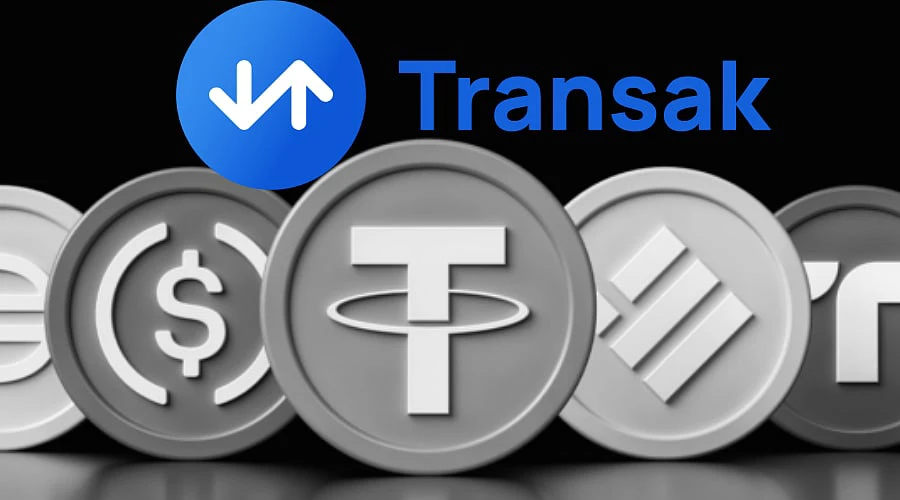McKinsey estimates that, at the current growth rate, daily volumes for stablecoins could reach $250 billion within the next three years.
Stablecoins are emerging as the backbone of digital money, offering stability, programmability, and global utility without the volatility of traditional cryptocurrencies.
Yet stablecoins can barely manage $30 billion in daily transaction volume currently, less than 1% of global transaction volume. For most users and financial apps, converting from fiat into stablecoins remains a fragmented, costly, and compliance-heavy process.
That’s where infrastructure providers like Transak chip in. By embedding compliance, payments, and conversion into a single native flow, Transak is making stablecoin onboarding as simple as a click.
This article explores how Transak abstracts complexity, powers global apps, and unlocks new financial use cases.
The Challenges in Traditional Stablecoin Onboarding
For most users, stablecoin onboarding often means juggling multiple platforms. They must register at an exchange, pass KYC, move funds, pay gas fees, and bridge to their app of choice.
For businesses, the backend is equally complex. They must balance fraud prevention, compliance, regional fiat rails, chargeback risks, and liquidity sourcing before they can start accepting stablecoin as payments.
This messy middle is where most of the friction lives. The biggest challenge in the process of abstracting this messy middle of stablecoin payments isn’t user demand. It’s stitching together dozens of infrastructure layers into a seamless experience.
Transak’s Approach: Abstracting Complexity
Transak solves this by embedding all the infrastructure layers,including auth, KYC/AML, risk checks, local payment rails, and crypto execution, into a modular, developer-friendly stack. Apps can integrate Transak via widget, API, or SDK, giving them flexibility while ensuring compliance and user trust.
Any business integrating Transak into its payments gets:
- Fully Native UX: Transak ensures that users never face confusing redirects or third-party aggregator flows. Instead, everything happens in-app, maintaining the brand identity of the partner application and delivering a seamless experience.
- Transparent Pricing: Stablecoin purchases through Transak happen with clear fees and minimal spreads. This transparency builds user trust and removes the hidden costs that often discourage adoption.
- Multiple Payment Methods: Transak supports a wide range of payment methods, including credit and debit cards, local bank transfers, and several regional payment options.
- Compliance Built-In: All transactions are safeguarded by integrated licensing, AML checks, and fraud protection. By embedding compliance into its core infrastructure, Transak removes one of the biggest hurdles for apps and FinTechs adopting stablecoins.
Transak’s List of Integrations
The strength of Transak’s model is best seen in its real-world integrations across wallets, fintechs, and exchanges.
- MetaMask Case Study: With Transak’s white-label API integration, users can deposit directly into MetaMask without popups or multiple redirects. The architecture even supports a PII-free model for enhanced privacy.
- DeFi Apps and fintech platforms: Wallets, DeFi apps, payroll platforms, and neobanks are embedding Transak to provide seamless fiat-stablecoin bridges. This includes partners like Binance US, Revolut, Ledger, Trust Wallet, PancakeSwap, and Robinhood.
- Binance US facilitates Direct fiat-to-crypto onboarding for U.S. users through embedded Transak flows.
- It provides seamless stablecoin purchasing and account funding inside one of the world’s most popular fintech apps, Revolut.
- Lightspark powers stablecoin flows with Transak’s deep liquidity integration.
- Remittances: Transak allows partner apps to seamlessly integrate fiat-to-USDC-to-fiat flows, enabling cheaper and faster global transfers than traditional correspondent banking systems.
What Sets Transak Apart?
Transak stands out by transforming one of the most complex pain points in digital finance, stablecoin onboarding, into a simple, branded, and compliant experience. Its blend of local payment rails, built-in compliance, and modular APIs gives FinTechs and Web3 apps an edge that few providers can match.
- Native Onboarding: Unlike aggregators, Transak powers 1:1 branded experiences.
- Compliance as a Feature: KYC, AML, and licensing handled out of the box.
- Local Rails: By building infrastructure country by country, Transak avoids the fragility of thin cross-border connections.
- Modular Flexibility: Apps choose only the modules they need, may it be Auth, KYC, Risk, or On/Off-Ramp.
- Future-Forward Vision: Transak’s roadmap aims for “any user, anywhere, in 1 click” onboarding.
How to Integrate & What to Expect
Integrating Transak is straightforward. Developers can embed a pre-built widget, customize APIs for deeper branding, or use SDKs for hybrid models. The developer experience is supported by clear documentation and onboarding guides.
Apps can configure payment methods, set regional availability, and align compliance tiers with their risk appetite. Within days, they can go live with seamless stablecoin onboarding.
